Travel: Chicago’s Lurie Garden

I was in Chicago recently for the garden writers conference. In addition to networking, we have the opportunity to visit amazing public and private gardens. Boy, do we all enjoy that! One public garden that particularly stands out is the Lurie Garden in Millennium Park.
Located between Monroe and Randolph Streets, along Michigan Avenue, Lurie Garden is actually a green roof on top of parking garages and part of their commuter railroad system.
The lush growth of the garden was such a lovely contrast to the downtown skyscrapers. Most of the plants are natives, particularly those that are drought-tolerant. They are a magnet for birds, butterflies, pollinators and beneficial insects.
The garden also provides a refuge for city dwellers to submerge themselves in nature. In addition, the garden helps reduce stormwater runoff by nearly 2 million gallons each year! The plants also improve the air quality, which is a huge benefit.
The staff who maintain the garden grow everything organically. They have reported seeing over 80 bird species and 10 species of butterflies. During our visit, we saw a lot of Monarch butterflies, mostly on or around the giant hyssop (Agastache x ‘Blue Fortune’ — see photo above). It was such a treat to watch them! I’m hoping to add some of this hyssop to my garden to see what it attracts.
Many spring-flowering bulbs have been planted in order to provide early season color. Examples are Camassia leichtlinii ‘Blue Danube’, Virginia bluebells, glory-of-the-snow, and Allium atropurpureum.
In the summer, visitors will see yarrow ‘Moonshine’, milkweed, pale coneflower, rattlesnake master (Eryngium yuccifolium), and white blazing star. There’s also Culver’s root (Veronicastrum) and Compass plant (Silphium laciniatum — another plant I was unfamiliar with). In the fall, there are sedums, Japanese anemone, goldenrod, and fountain grass, among many others.
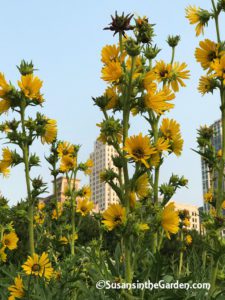
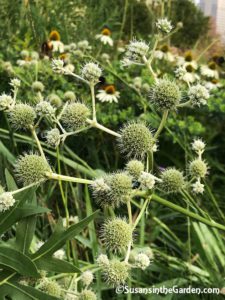
Above: Compass plant, Rattlesnake master.
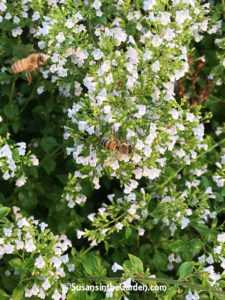
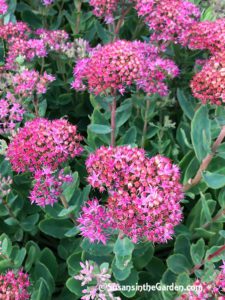
Above: Calamintha nepeta, Sedum showy stonecrop.
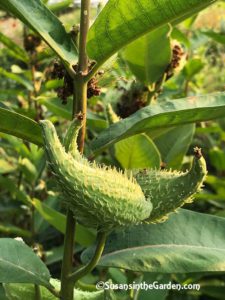
Milkweed seedpods above
Winter interest is provided by the allium seedheads and Northern sea oats. The coneflower heads, globe thistle and sea holly contribute to the scene. All of these are left for birds and animals to eat during the colder months of the year.
While we explored the Lurie Garden in mid-August, it’s clear the plants provide year-round interest for all visitors.
This garden has been made possible by an endowment from Ann Lurie in memory of her husband, Bob, who was a real estate investor and entrepreneur.
To learn more about the Lurie Garden, go to luriegarden.org, and for more information about Millennium Park, go to millenniumparkfoundation.org.


